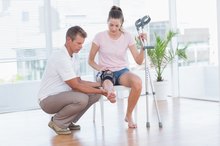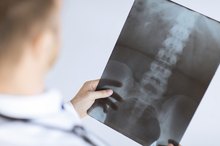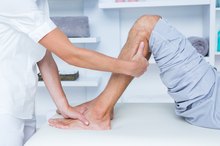How to Treat a Deep Bone Bruise of the Knee
A bruise occurs when capillaries (small blood vessels) break and bleed into the surrounding tissue. According to the National Institutes of Health, a bruise can occur underneath the skin, within the belly of a muscle or within a bone. Most bruises heal on their own; however, a bruise can result in compartment syndrome. Compartment syndrome is an increase in pressure that can decrease the blood supply to tissues or organs around the bruise. You will notice excessive pain, swelling, numbness, tingling or weakness in your lower limb if compartment syndrome develops because of a deep bone bruise of the knee. This complication is life threatening, and you should seek immediate medical treatment. Use the following guidelines to promptly treat a deep bone bruise of the knee.
Elevate the injured knee above the level of your heart, advises the Mayo Clinic 1. Lie down and place your knee and foot on a pillow so that your entire lower leg is elevated to ease swelling.
How to Recover from a Knee Bone Bruise Caused by Running
Learn More
Apply an ice pack to the bruised knee for 20 minutes. Remove the ice pack for 20 minutes. Repeat this cycle several times during the day to reduce pain and swelling in the knee.
Consider taking over-the-counter nonsteroidal anti-inflammatory drugs (NSAIDs), such as Aleve, ibuprofen or Motrin, to reduce pain and swelling. Follow the instructions on the drug label and use as directed. Consult your doctor about taking these medications.
How to Care for a Bruised Knee
Learn More
Rest the bruised knee as much as possible. Avoid using crutches, if possible, to prevent the knee from becoming stiff.
See your doctor if you have extreme pain or an unusually large bruise, if you heard a “pop” or a “snap,” if you have a history of a bleeding disorder or if you are bleeding from other areas of your body.
Tips
Do not place ice directly on the skin.
Warnings
Do not try to drain the bruise with a needle. Do not overexercise your bruised knee.
Related Articles
References
- Mayo Clinic: Bruise First Aid
- Medline Plus: Bruise
- Lespasio MJ, Piuzzi NS, Husni ME, Muschler GF, Guarino A, Mont MA. Knee Osteoarthritis: A Primer. Perm J. 2017;21:16-183. doi:10.7812/TPP/16-183
- Kiapour AM, Murray MM. Basic science of anterior cruciate ligament injury and repair. Bone Joint Res. 2014;3(2):20-31. doi:10.1302/2046-3758.32.2000241
- Doral MN, Bilge O, Huri G, Turhan E, Verdonk R. Modern treatment of meniscal tears. EFORT Open Rev. 2018;3(5):260-268. doi:10.1302/2058-5241.3.170067
- Reinking MF. CURRENT CONCEPTS IN THE TREATMENT OF PATELLAR TENDINOPATHY. Int J Sports Phys Ther. 2016;11(6):854-866.
- Petersen W, Rembitzki I, Liebau C. Patellofemoral pain in athletes. Open Access J Sports Med. 2017;8:143-154. doi:10.2147/OAJSM.S133406
- Frush TJ, Noyes FR. Baker's Cyst: Diagnostic and Surgical Considerations. Sports Health. 2015;7(4):359-65. doi:10.1177/1941738113520130
- Huang YC, Yeh WL. Endoscopic treatment of prepatellar bursitis. Int Orthop. 2011;35(3):355-8. doi:10.1007/s00264-010-1033-5
- Beals C, Flanigan D. A Review of Treatments for Iliotibial Band Syndrome in the Athletic Population. J Sports Med (Hindawi Publ Corp). 2013;2013:367169. doi:10.1155/2013/367169
- Tsai CH, Hsu CJ, Hung CH, Hsu HC. Primary traumatic patellar dislocation. J Orthop Surg Res. 2012;7:21. doi:10.1186/1749-799X-7-21
- Ragab G, Elshahaly M, Bardin T. Gout: An old disease in new perspective - A review. J Adv Res. 2017;8(5):495-511. doi:10.1016/j.jare.2017.04.008
- Lee PYF, Nixion A, Chandratreya A, Murray JM. Synovial Plica Syndrome of the Knee: A Commonly Overlooked Cause of Anterior Knee Pain. Surg J (N Y). 2017;3(1):e9-e16. doi:10.1055/s-0037-1598047
- Vaishya R, Azizi AT, Agarwal AK, Vijay V. Apophysitis of the Tibial Tuberosity (Osgood-Schlatter Disease): A Review. Cureus. 2016;8(9):e780. doi:10.7759/cureus.780
- Zanon G, Di vico G, Marullo M. Osteochondritis dissecans of the knee. Joints. 2014;2(1):29-36.
- Hindle P, Davidson E, Biant LC. Septic arthritis of the knee: the use and effect of antibiotics prior to diagnostic aspiration. Ann R Coll Surg Engl. 2012;94(5):351-5. doi:10.1308/003588412X13171221591015
- Gwinner C, Märdian S, Schwabe P, Schaser KD, Krapohl BD, Jung TM. Current concepts review: Fractures of the patella. GMS Interdiscip Plast Reconstr Surg DGPW. 2016;5:Doc01. doi:10.3205/iprs000080
- Voskuil R, Evenski AJ, Montgomery C, Emory CL. Malignant Bone Tumors of the Knee: How to Identify and Treat. J Knee Surg. 2019;32(4):305-314. doi:10.1055/s-0038-1675828
- Gupte C, St mart JP. The acute swollen knee: diagnosis and management. J R Soc Med. 2013;106(7):259-68. doi:10.1177/0141076813482831
- American Academy of Orthopedic Surgeons. Unstable Kneecap.
- Bhatia D, Bejarano T, Novo M. Current interventions in the management of knee osteoarthritis. Journal of Pharmacy & Bioallied Sciences 2013 Jan-Mar;5(1):30-38. doi:%2010.4103/0975-7406.106561
- Bronstein RD, Schaffer JC. Physical Examination of the Knee: Meniscus, Cartilage, and Patellofemoral Conditions. J Am Acad Orthop Surg. 2017 May;25(5):365-374.
- Browne K, Kurtz CA. How to perform a comprehensive examination of the knee. JAAPA. 2009 Jun;22(6):20-25.
- Hergenroeder AC, Harvey BS. (2017). Osteochondritis dissecans (OCD): Clinical manifestations and diagnosis. Bachur RG, ed. UpToDate. Waltham, MA: UpToDate Inc.
Writer Bio
As a physical medicine and rehabilitation physician I have extensive experience in musculoskeletal/neurological medicine that will benefit the network.









